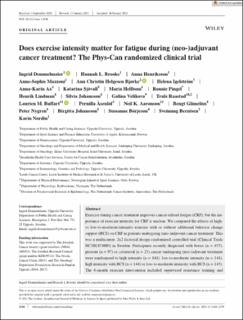Does exercise intensity matter for fatigue during (neo-)adjuvant cancer treatment? The Phys-Can randomized clinical trial
Demmelmaier, Ingrid; Brooke, Hannah L.; Henriksson, Anna; Mazzoni, Anne-Sophie; Bjørke, Ann Christin Helgesen; Igelström, Helena; Ax, Anna-Karin; Sjövall, Katarina; Hellbom, Maria; Pingel, Ronnie; Lindman, Henrik; Johansson, Silvia; Velikova, Galina; Raastad, Truls; Buffart, Laurien M.; Åsenlöf, Pernilla; Aaronson, Neil K.; Glimelius, Bengt; Nygren, Peter; Johansson, Birgitta; Börjeson, Sussanne; Berntsen, Sveinung; Nordin, Karin
Peer reviewed, Journal article
Published version
Permanent lenke
https://hdl.handle.net/11250/2777320Utgivelsesdato
2021Metadata
Vis full innførselSamlinger
Originalversjon
Demmelmaier, I., Brooke, H. L., Henriksson, A., Mazzoni, A.-S., Bjørke, A. C. H., Igelström, H., Ax, A.-K., Sjövall, K., Hellbom, M., Pingel, R., Lindman, H., Johansson, S., Velikova, G., Raastad, T., Buffart, L. M., Åsenlöf, P., Aaronson, N. K., Glimelius, B., Nygren, P., Johansson, B., Börjeson, S., Berntsen, S. & Nordin, K. (2021). Does exercise intensity matter for fatigue during (neo-)adjuvant cancer treatment? The Phys-Can randomized clinical trial. Scandinavian Journal of Medicine & Science in Sports, 31 (5), 1144-1159. https://doi.org/10.1111/sms.13930Sammendrag
Exercise during cancer treatment improves cancer-related fatigue (CRF), but the importance of exercise intensity for CRF is unclear. We compared the effects of high- vs low-to-moderate-intensity exercise with or without additional behavior change support (BCS) on CRF in patients undergoing (neo-)adjuvant cancer treatment. This was a multicenter, 2x2 factorial design randomized controlled trial (Clinical Trials NCT02473003) in Sweden. Participants recently diagnosed with breast (n = 457), prostate (n = 97) or colorectal (n = 23) cancer undergoing (neo-)adjuvant treatment were randomized to high intensity (n = 144), low-to-moderate intensity (n = 144), high intensity with BCS (n = 144) or low-to-moderate intensity with BCS (n = 145). The 6-month exercise intervention included supervised resistance training and home-based endurance training. CRF was assessed by Multidimensional Fatigue Inventory (MFI, five subscales score range 4-20), and Functional Assessment of Chronic Illness Therapy-Fatigue scale (FACIT-F, score range 0-52). Multiple linear regression for main factorial effects was performed according to intention-to-treat, with post-intervention CRF as primary endpoint. Overall, 577 participants (mean age 58.7 years) were randomized. Participants randomized to high- vs low-to-moderate-intensity exercise had lower physical fatigue (MFI Physical Fatigue subscale; mean difference −1.05 [95% CI: −1.85, −0.25]), but the difference was not clinically important (ie <2). We found no differences in other CRF dimensions and no effect of additional BCS. There were few minor adverse events. For CRF, patients undergoing (neo-)adjuvant treatment for breast, prostate or colorectal cancer can safely exercise at high- or low-to-moderate intensity, according to their own preferences. Additional BCS does not provide extra benefit for CRF in supervised, well-controlled exercise interventions.

